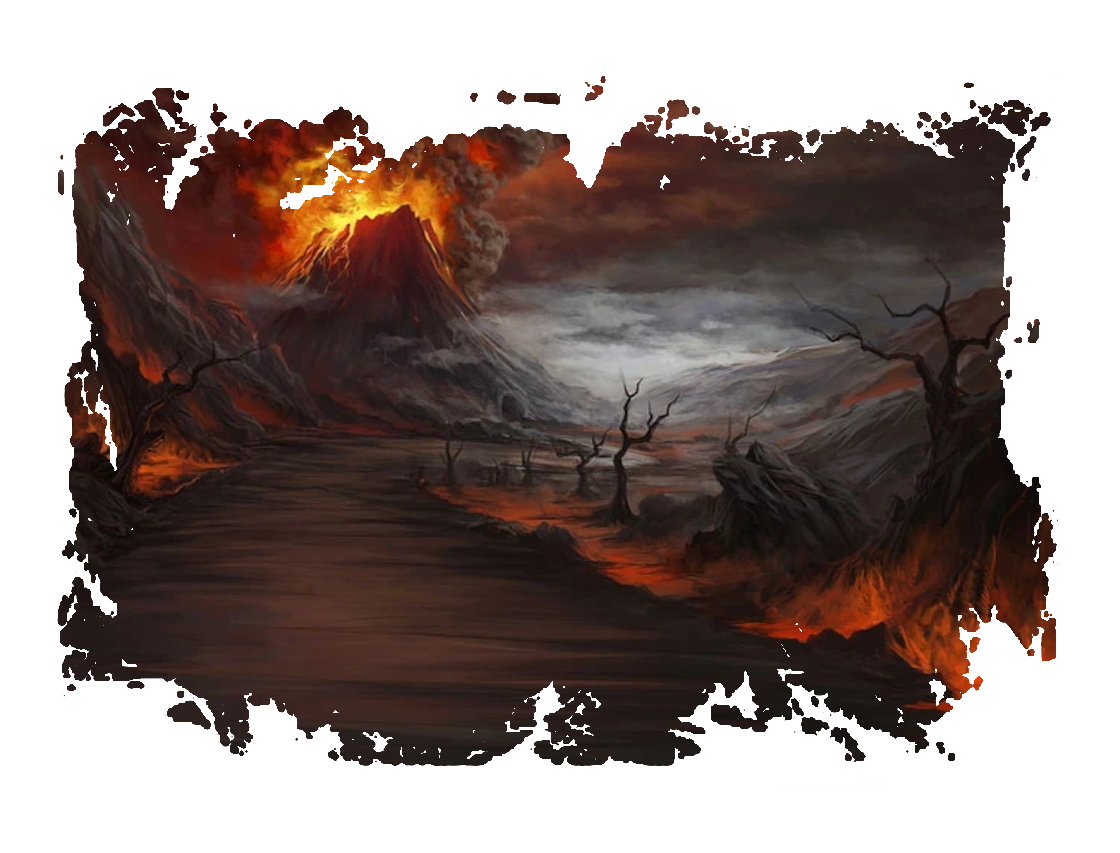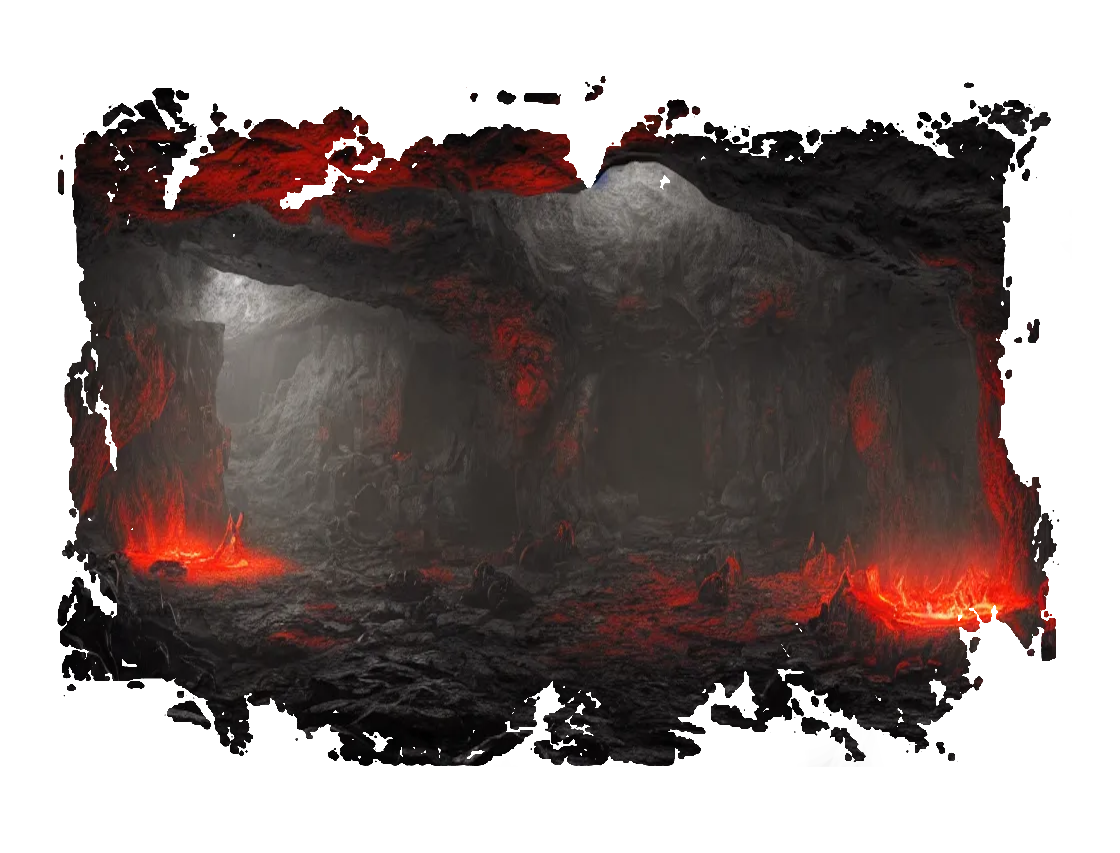
The Magma Region - Zul
in Yunan's World AtlasFount of Obsidian
"As the sky darkened ominously, Mina stood transfixed at the edge of the cliff, her eyes fixed on the horizon where the once dormant supervolcano now roared to life. A cacophony of thunderous rumbles echoed through the valley, drowning out even the howling wind. Ribbons of fiery lava erupted from the massive caldera, painting the night sky with an eerie crimson glow. The earth quivered beneath her feet as plumes of ash and smoke billowed high into the stratosphere, blotting out the stars. Despite the danger, Mina couldn't tear her gaze away from the awe-inspiring spectacle unfolding before her, a reminder of nature's unstoppable power and the fragility of human existence in its wake." - Excerpt from Yunan's Guide to the RealmRegion Info
Alternative NamesThe Magma Region, The Underground, The Crucible
Ruling Kingdom
The Darkhold
Major Languages
Goblin, Elven, Dwarven
Prominent Demographics
Goblins, Dark Elves, Dwarves
Overview
Zul's surface is a sweeping land of mighty volanic peaks and mounds of geothermal springs. It's flatlands are dark in color, and many are bare hellscapes of parched, black earth. Near the coast and the southern lands there exists primodial looking grasslands with sparse but maintained fields o0f crops and wild grass, fed by the nutrient rich volcanic soils. Zul's most striking feature lies beneath its surface—an expansive subterranean realm. Spanning miles across the southern continent it shares with Azimuth, Zul is a maze of caverns, lava tubes, and corridors. This underground world, home to a unique way of life, is illuminated only by rivers of lava and bioluminescent insects feeding on glowing moss.The tunnels serve as roadways between vast underground dens, where humanoids carve homes and facilities from the stone. The silence of the depths is punctuated by the earth's shifting groans and the rush of unseen underground waters.
Zul is inhabited by three subterranean races: the clever goblins, the stoic dwarves, and the enigmatic dark elves. These beings coexist and clash, shaping the region's history and mastering its geothermal powers. Hidden beneath the surface are three distinct kingdoms, connected by a central city where their paths converge.
Climate
The caves of Zul vary from gaping stone mouths plunging into darkness to modest ground holes resembling mole dens. These unassuming entrances often conceal vast, breathtaking chambers, attracting explorers intrigued by the mystery of what lies within. Questions like, "What’s around the next bend?" or "How far does this passage go?" captivate visitors drawn to Zul's ash-covered fields.Light barely penetrates the first few meters of these caves, leaving the rest cloaked in total darkness. The caverns maintain stable temperatures with high humidity: lower caves remain cool due to water and the absence of sunlight, while mountain caverns stay warmer, insulated by stone against the frost beyond. Deeper into Zul, temperatures rise near volcanic vents and lava flows, heating the surrounding tunnels.
Zul's caves are largely unaffected by weather, though rain and seismic activity can reshape water and sediment pathways. Above ground, the ash fields are perpetually overcast. Volcanic gases, ash, and heat create thick clouds that mix with cooler air, resulting in frequent heavy rains and rare clear skies.
Natural Resources
Zul thrives on its abundant natural resources, leveraging its earthen refuge to fuel its economy, lifestyle, and culture. The region's mines yield valuable minerals like calcium, gypsum, and quartz from stalactites and flowstones. Many tap Zul's trade routes for access to metals, some common such as iron, lead, and silver, whilst others are more specialized and rare but abundant in Zul, such as titanium and the prized aurelium, all of which drive significant exports. Unique resources also add to Zul's wealth: bat guano, harvested from local cave-dwelling species, serves as a highly effective fertilizer for areas with poor soil. The volcanic soils of Zul's surface, enriched by mineral-rich volcanic rocks, support high-quality farming. Crops grown here sustain local villages and provide essential supplements to underground communities.Society
Life in Zul varies greatly between its surface and underground regions.On the surface, small villages and hamlets thrive, adapted to the fertile volcanic lowlands around mountains and volcanoes. Farming communities use the nutrient-rich soil to produce abundant crops, feeding both themselves and nearby areas. Many towns maintain large storage facilities, where underground communities pay to store minerals for later trade. In return, these subterranean dwellers purchase large quantities of crops to sustain their populations.
Below the surface, Darkhold serves as the central hub for the goblins, dwarves, and dark elves, who coexist in an uneasy peace despite historical tensions. Goblins typically live near the surface in communal warrens resembling rodent burrows, the biggest community of which is known as Cogspur. Dwarves reside in Gorinzan, an imposing fortress of carved stone, featuring organized tunnels, workshops, stores, and places of worship. The dark elves dwell in Nihlasari Keep, a majestic stronghold built into the ceiling above a lake of molten rock, blending elements of dwarven architecture.
In Darkhold, goblins often work in dwarven forges and workshops, valued for their size and ingenuity in maintaining equipment and crafting fine jewelry and locks. Dwarves run many family-owned businesses, while dark elf houses dominate magical crafting, enchanting, and trade, generating substantial wealth. Though the three groups cooperate out of necessity, conflicts and feuds remain common.
World Codex
Story & Moderation Team: ames, capolock, foxhound99, skarra365, 1800HOTBEEF, Nekobot
Community Manager: staratly
Website Manager: foxhound99, skarra365
Community Manager: staratly
Website Manager: foxhound99, skarra365




